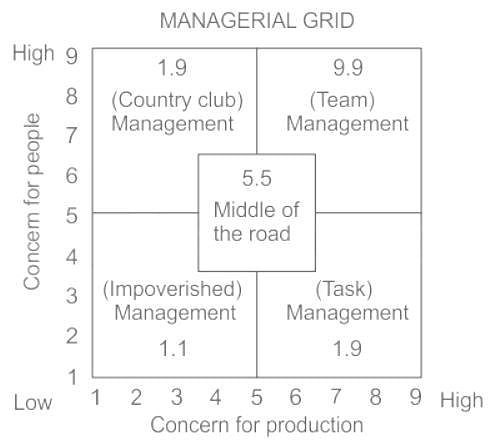UGC NET Exam > UGC NET Questions > The Managerial Grid model was developed by __...
Start Learning for Free
The Managerial Grid model was developed by __________.
- a)Hersey and Blanchard
- b)Fiedler
- c)R.R. Blake and J. Mouton
- d)Mckinsey
Correct answer is option 'C'. Can you explain this answer?
| FREE This question is part of | Download PDF Attempt this Test |
Most Upvoted Answer
The Managerial Grid model was developed by __________.a)Hersey and Bla...
The Managerial Grid model was developed by R.R. Blake and J. Mouton. This model is a behavioral leadership model that helps managers assess their leadership style based on their concern for people and concern for production. The model is represented by a grid with two axes - concern for people and concern for production.
The two axes of the Managerial Grid model are:
1. Concern for people: This refers to a manager's focus on the well-being, satisfaction, and development of their employees. Managers who have a high concern for people prioritize building relationships, supporting their team members, and creating a positive work environment.
2. Concern for production: This refers to a manager's focus on achieving goals, meeting targets, and ensuring productivity. Managers who have a high concern for production prioritize task completion, efficiency, and meeting deadlines.
The five leadership styles identified in the Managerial Grid model are:
1. Country Club Management (1,9): Managers with this style have a high concern for people but a low concern for production. They prioritize creating a harmonious work environment and building positive relationships with their employees. However, they may neglect task completion and fail to push their team towards achieving goals.
2. Team Management (9,9): Managers with this style have a high concern for both people and production. They aim to create a supportive work environment while also focusing on achieving goals. This style is considered to be the most effective as it balances the needs of both employees and the organization.
3. Middle-of-the-Road Management (5,5): Managers with this style have a moderate concern for both people and production. They try to strike a balance between task completion and employee satisfaction. However, this style may not be as effective as the Team Management style.
4. Impoverished Management (1,1): Managers with this style have a low concern for both people and production. They typically avoid getting involved in conflicts or making decisions. This style can result in a lack of direction and poor performance.
5. Authority-Compliance Management (9,1): Managers with this style have a high concern for production but a low concern for people. They prioritize achieving goals and meeting targets, often at the expense of employee satisfaction. This style can lead to a negative work environment and low employee morale.
The Managerial Grid model helps managers understand their leadership style and its impact on their team's performance. By assessing their concern for people and production, managers can identify areas for improvement and develop a more effective leadership approach.
Free Test
FREE
| Start Free Test |
Community Answer
The Managerial Grid model was developed by __________.a)Hersey and Bla...
Managerial Grid model of leadership
- The managerial grid model (1964) is a style leadership model developed by Robert R. Blake and Jane Mouton.
- This model originally identified five different leadership styles based on the concern for people and the concern for production.
- In this style, managers have low concern for both people and production.
- The Managerial or Leadership Grid is used to help managers analyze their own leadership styles through a technique known as grid training.
- This is done by administering a questionnaire that helps managers identify how they stand with respect to their concern for production and people.
- The Leadership Grid is a model of behavioral leadership developed in the 1960s to measure concern for production against concern for people.
The grid identifies five types of leaders:
- Impoverished
- Produce or Perish
- Middle of the Road
- Country Club
- Team.
The two dimensions of leadership, viz. concern for people on the ‘vertical’ axis and concern for production on the ‘horizontal’ axis.

Managerial Grid Model is based on two behavioral dimensions:
- Concern for people: This is the degree to which a leader considers the needs of team members, their interests, and areas of personal development when deciding how best to accomplish a task.
- Concern for production: This is the degree to which a leader emphasizes concrete objectives, organizational efficiency, and high productivity when deciding how best to accomplish a task.
Attention UGC NET Students!
To make sure you are not studying endlessly, EduRev has designed UGC NET study material, with Structured Courses, Videos, & Test Series. Plus get personalized analysis, doubt solving and improvement plans to achieve a great score in UGC NET.

|
Explore Courses for UGC NET exam
|

|
Similar UGC NET Doubts
The Managerial Grid model was developed by __________.a)Hersey and Blanchardb)Fiedlerc)R.R. Blake and J. Moutond)MckinseyCorrect answer is option 'C'. Can you explain this answer?
Question Description
The Managerial Grid model was developed by __________.a)Hersey and Blanchardb)Fiedlerc)R.R. Blake and J. Moutond)MckinseyCorrect answer is option 'C'. Can you explain this answer? for UGC NET 2024 is part of UGC NET preparation. The Question and answers have been prepared according to the UGC NET exam syllabus. Information about The Managerial Grid model was developed by __________.a)Hersey and Blanchardb)Fiedlerc)R.R. Blake and J. Moutond)MckinseyCorrect answer is option 'C'. Can you explain this answer? covers all topics & solutions for UGC NET 2024 Exam. Find important definitions, questions, meanings, examples, exercises and tests below for The Managerial Grid model was developed by __________.a)Hersey and Blanchardb)Fiedlerc)R.R. Blake and J. Moutond)MckinseyCorrect answer is option 'C'. Can you explain this answer?.
The Managerial Grid model was developed by __________.a)Hersey and Blanchardb)Fiedlerc)R.R. Blake and J. Moutond)MckinseyCorrect answer is option 'C'. Can you explain this answer? for UGC NET 2024 is part of UGC NET preparation. The Question and answers have been prepared according to the UGC NET exam syllabus. Information about The Managerial Grid model was developed by __________.a)Hersey and Blanchardb)Fiedlerc)R.R. Blake and J. Moutond)MckinseyCorrect answer is option 'C'. Can you explain this answer? covers all topics & solutions for UGC NET 2024 Exam. Find important definitions, questions, meanings, examples, exercises and tests below for The Managerial Grid model was developed by __________.a)Hersey and Blanchardb)Fiedlerc)R.R. Blake and J. Moutond)MckinseyCorrect answer is option 'C'. Can you explain this answer?.
Solutions for The Managerial Grid model was developed by __________.a)Hersey and Blanchardb)Fiedlerc)R.R. Blake and J. Moutond)MckinseyCorrect answer is option 'C'. Can you explain this answer? in English & in Hindi are available as part of our courses for UGC NET.
Download more important topics, notes, lectures and mock test series for UGC NET Exam by signing up for free.
Here you can find the meaning of The Managerial Grid model was developed by __________.a)Hersey and Blanchardb)Fiedlerc)R.R. Blake and J. Moutond)MckinseyCorrect answer is option 'C'. Can you explain this answer? defined & explained in the simplest way possible. Besides giving the explanation of
The Managerial Grid model was developed by __________.a)Hersey and Blanchardb)Fiedlerc)R.R. Blake and J. Moutond)MckinseyCorrect answer is option 'C'. Can you explain this answer?, a detailed solution for The Managerial Grid model was developed by __________.a)Hersey and Blanchardb)Fiedlerc)R.R. Blake and J. Moutond)MckinseyCorrect answer is option 'C'. Can you explain this answer? has been provided alongside types of The Managerial Grid model was developed by __________.a)Hersey and Blanchardb)Fiedlerc)R.R. Blake and J. Moutond)MckinseyCorrect answer is option 'C'. Can you explain this answer? theory, EduRev gives you an
ample number of questions to practice The Managerial Grid model was developed by __________.a)Hersey and Blanchardb)Fiedlerc)R.R. Blake and J. Moutond)MckinseyCorrect answer is option 'C'. Can you explain this answer? tests, examples and also practice UGC NET tests.

|
Explore Courses for UGC NET exam
|

|
Suggested Free Tests
Signup for Free!
Signup to see your scores go up within 7 days! Learn & Practice with 1000+ FREE Notes, Videos & Tests.
























